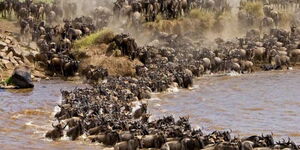There was a historic moment in the Solio area, Nyeri County, as the heaviest elephant ever recorded in Kenya was captured by Kenya Wildlife Service (KWS) officers.
The elephant, which weighed over 10,000 kg (10 tonnes), was spotted during a recent translocation of the animals from the Solio area.
In a statement, KWS revealed that the elephant’s sheer weight posed a challenge to rangers from the Vet and Capture Unit, who had to devise a unique way to transport the animal.
"After nearly seven decades, the heaviest elephant in Kenya’s history, weighing over 10,000 kg (10 tonnes), was recorded during the recently concluded elephant translocation from the Solio area," KWS announced.
According to KWS, the elephant was so massive that it took the combined effort of two cranes to safely relocate the jumbo to the Aberdare ecosystem.
Adult elephants, the largest land mammals on Earth, typically weigh around 5,400 kilograms (12,000 pounds). African elephants are larger than their Asian counterparts and can reach towering heights of over 10.5 feet (3.2 meters) at the shoulder.
The elephant’s enormous size is the result of evolutionary pressures, including competition from other herbivores and the need to defend itself against larger predators. These factors drove the species to grow in size, allowing them to reach higher vegetation and enhance their survival.
To put the scale of this 10-tonne elephant into perspective, the last time such a sight was recorded was in 1956, when the largest known elephant, nicknamed The Giant of Angola, roamed the Earth. The massive beast stood 13 feet (3.96 meters) at the shoulder and weighed an astonishing 10,400 kilograms.
Unfortunately, The Giant of Angola was hunted down, but its skin remains on display at the National Museum of Natural History in Washington, D.C.
KWS revealed that the translocation of this elephant was part of a broader effort to conserve the species, whose population is alarmingly dwindling.
According to the Mara Elephant Project, Kenya’s elephant population stood at 167,000 in 1973. However, due to increasing human-wildlife conflict and relentless poaching for ivory, that number had dropped to fewer than 40,000 by 2021.
"This monumental effort underscores our ongoing commitment to conserving Kenya’s wildlife and protecting these magnificent species for future generations," KWS stated.












